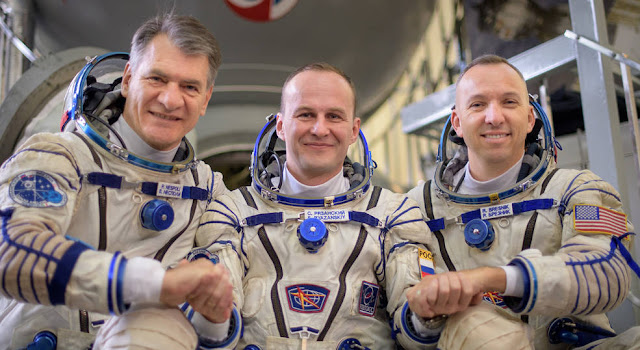READY FOR LIFT OFF: Friday morning, three humans will be leaving Earth behind for awhile. The astronauts and cosmonaut will be lifting off rom the Baikonur Cosmodrome in Kazakhstan on July 28. Live launch coverage will begin at 7:45 a.m. EDT on NASA Television and the agency’s website, with the launch set for 8:41 a.m.
Expedition 52/53 crew members are NASA astronaut Randy Bresnik, Sergey Ryazanskiy of Roscosmos and Paolo Nespoli of the European Space Agency.
Post launch, the trio will make a six hour trip in a Soyuz MS-05 spacecraft to the International Space Station. Docking is expected to happen at 3 p.m. Pacific time. NASA coverage will commence at 2:15 p.m. The hatches between the Soyuz and the station are set to open about 4:40 p.m.
The new crew will be joining Fyodor Yurchikhin of Roscosmos and Flight Engineers Peggy Whitson and Jack Fischer of NASA on board the ISS. Coverage of hatch opening and welcoming ceremonies will begin at 4 p.m., Pacific time.
For more about all of the amazing things going on on board the ISS, visit: https://www.nasa.gov/station
Tonight, we were thrilled to have a chance to see the ISS fly overhead. We happened to be in a Safeway parking lot when it happened, and a young family parked next to us heard us geeking out and they were super excited about seeing the space station. They'd never seen it fly over before, and didn't even know one could, so it was fun to share that info with them. Yay for NASA outreach!
In an email today from the Jet Propulsion Laboratory, we learned about how high altitude balloons will be used to help broadcast and study the upcoming event.
 |
| Led by Angela Des Jardins of Montana State University, NASA's Eclipse Balloon Project is sending more
than 50 high-altitude balloons launched by student teams across the U.S.
to livestream aerial footage of the Aug. 21 total solar eclipse from
the edge of space to NASA's website. Per the JPL press release, "Total solar eclipses are rare and awe-inspiring events. Nobody has ever live-streamed aerial video footage of a total solar eclipse before," said Angela Des Jardins. "By live-streaming it on the Internet, we are providing people across the world an opportunity to experience the eclipse in a unique way, even if they are not able to see the eclipse directly." Jim Green, director of planetary science at NASA Headquarters in Washington, said, "The August solar eclipse gives us a rare opportunity to study the stratosphere when it's even more Mars-like than usual. With student teams flying balloon payloads from dozens of points along the path of totality, we'll study effects on microorganisms that are coming along for the ride." NASA will provide each team with two small metal cards, each the size of a dog tag. The cards have harmless, yet environmentally resilient bacteria dried onto their surface. One card will fly up with the balloon while the other remains on the ground. A comparison of the two will show the consequences of the exposure to Mars-like conditions, such as bacterial survival and any genetic changes. Beyond the opportunity for NASA to conduct science, this joint project provides the opportunity for students as young as 10 years old to be exposed to the scientific method and astrobiology -- research about life beyond Earth. Since ballooning is such an accessible and low-cost technique, the project has attracted student teams from Puerto Rico to Alaska. |


No comments:
Post a Comment